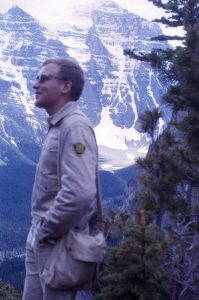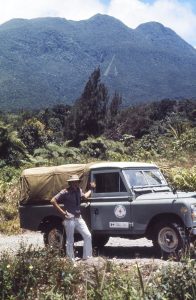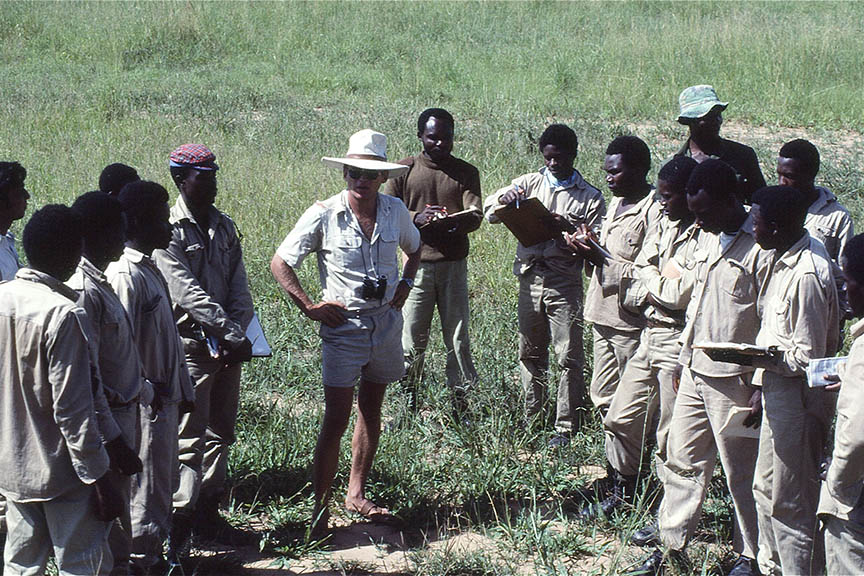Jim Thorsell, an old friend, who inspired the first edition of the Canadian Rockies Trail Guide and contributed to the first six editions, died on August 30, 2023.
“Thor” was an avid hiker who authored one of the first backcountry user surveys in 1967, A Trail Use Survey: Banff and Yoho National Park. Among a long list of recommendations, we took special note of the following:

Jim Thorsell poses with the IUCN World Heritage Site plaque at Lake Louise in October, 1988. In addition to his role inspiring the first edition of the Canadian Rockies Trail Guide, he was instrumental in establishing the contiguous Mountain National and Provincial Parks as a World Heritage site. Photo by Brian Patton.
“The key to public use of our many superb mountain areas of the west is not so much development but provision of information. Many visitors expressed an almost frantic desire for trail information they could not get from information officers or trail maps.”
He went on to recommend an “illustrated trail guide… complete with maps would be a major information need for each of our parks”.
That recommendation triggered plans by myself and Bart Robinson to create the first hiker-specific guidebook to the Mountain Parks. Thor provided feedback throughout the process, and we used his trail inventories for Banff and Yoho during our fieldwork in 1970. We also followed his recommendation that the book should be comprehensive in hopes of spreading use beyond the most popular trails
The 1967 survey also provided a detailed proposal for a Great Divide Trail. After more fieldwork and route refining, Thorsell published the Provisional Trail Guide and Map for the Proposed Great Divide Trail in 1970. With his permission, we summarized that publication in our first edition the following year and subsequent editions until 2000.
Early life in the Mountain Parks

Jim Thorsell leading a guided walk to Saddleback above Lake Louise in the early 1960s. Jim Thorsell collection.
James Westvick Thorsell was born on December 5, 1940, in Wetaskiwin, Alberta. He would eventually make his way to the University of Alberta, where he earned a Bachelor of Science degree in 1962.
That year he was hired as Banff’s first seasonal park naturalist. It was a posting that included guided walks on the trails at Lake Louise and evening programs at the Bow Lake Campground. It began an attachment to the park that would last the rest of his life.
While earning a Master of Arts degree from the University of Western Ontario (1968), he completed two of the earliest trail use surveys for Waterton Lakes and Banff & Yoho National Parks.
In 1971, he completed an interdisciplinary PhD with specialization in parks management at the University of British Columbia. It was one of the first doctorates in that field ever awarded in Canada.
During this first decade, he purchased a small cottage in Banff with the help of his good friend Catharine Robb Whyte, founder of the Whyte Museum of the Canadian Rockies.
Following the publication of his Great Divide Trail proposal and the first edition of the Canadian Rockies Trail Guide, he joined myself and Jon Whyte as instructors in the “Anatomy of the Canadian Rockies” at the Banff School of Fine Arts (Banff Centre). This summer student program, which ran from 1973 until 1977, included daily lectures on natural and human history and guided hikes every weekend on a wide variety of trails between Banff and the Columbia Icefield.
In 1977, he was hired as an Assistant Professor with tenure at the University of Alberta, and he purchased a house in Edmonton. But the academic life and the big city didn’t agree with his disposition (he spent most every weekend in Banff), so he resigned his position in 1979. (One of my favourite Thor quotes comes from when he listed his Edmonton house: “I can be out in 10 minutes.”)
International career

Jim Thorsell’s first international posting on the Caribbean island of Dominica, circa 1978. Jim Thorsell collection.
Other than a small circle of friends, not many people were aware of the role Thor played in world conservation after he left Banff.
He began his career in international parks and conservation in the late 1970s when he signed on as a planner for Morne Trois Pitons National Park on the Caribbean island nation of Dominica.
While he was designing the park’s focal point trail, Catharine Whyte travelled to the island for a visit and to observe his project. (It would be one of the last trips abroad for Catharine, who passed away in March, 1979.)
The lure of worldwide conservation would capture Thor’s attention for the next two decades.
From 1979 until 1981 he worked as a planner for the Kenya Wildlife Department. His base of operations was the Karen Blixen farm (Out of Africa) in the Ngong Hills southwest of Nairobi.
In 1982-83, he was a lecturer at the College of African Wildlife Management at the foot of Mount Kilimanjaro in Tanzania. From that base, he ranged out on numerous trips to explore the vast Serengeti.
While he was at the latter posting, he was offered a position at the International Union for Conservation Nature & Natural Resources (UUCN) in Gland, Switzerland. It was a difficult decision to leave Africa at the time, but it would lead him into a major role in world conservation.
World Heritage
Thor arrived at the IUCN headquarters in Gland, Switzerland in 1983. He first headed the World Commission on Protected Areas before taking over responsibility for the World Heritage program.
Under his leadership, field missions were introduced in 1985 for the evaluation of all natural sites nominated for World Heritage status. A few years later, the IUCN World Heritage panel was created to improve the quality of assessments.
During his career with IUCN, he carried out missions to more than 600 protected sites in 90 countries and authored more than 300 publications on nature conservation and park management.

He would travel to China more than 16 times during his career to assess natural areas. Despite an often hostile reception in areas of Australia and New Zealand, he was revered in many Chinese communities, where World Heritage was considered a welcome designation.
Photographs taken during his China visits show hundreds of people lining the streets in welcome, and he may well have been the most famous Canadian in China since Dr. Norman Bethune. (I accused him of passing himself off as Bethune’s son and joked that if the Chinese ever discovered he wasn’t, he’d be in big trouble.)
On August 11, 2010, Christina Cameron travelled to Banff to interview Thor for the World Heritage Centre Oral Archives. This 29-minute taped interview provides his views on the successes and failures of the World Heritage Convention.
Relocation to British Columbia

Nancy and Thor dining in the Columbia Valley following their move to BC. Brian Patton photo.
In 2001, Thor and his partner Nancy Knechtel moved from Banff to a restored log home in the hamlet of Wilmer, BC, with an unparalleled view of the Columbia Valley wetlands.
Together they spent winters in Ajijic and Baja, Mexico, and summers in Wilmer. Wherever they were, they entertained professional colleagues and mountain friends.
He continued his involvement with the IUCN for many years following the move and reacquainted himself with many trails in the mountain parks he’d surveyed in his early days. In 2016, he hiked the Rockwall Trail again from end-to-end, a trail that he revised into his proposed Great Divide Trail 46 years earlier (see Park Wardens: Past & Present hiker’s blog).
Thor was a focussed individual who carefully crafted his life, both personally and professionally wherever he was in the world, so he could always be out in nature, hiking, scrambling, fishing and hunting. I’ll always remember his voice mail: “I’m in the backcountry. Leave a message.”
What more can I say about an individual who was such an important influence on my own life? Perhaps I should simply sign off with his favourite quote, which was a motto for his life:
“Climb the mountains and get their good tidings. Nature’s peace will flow into you as the sunshine into the trees. The winds will blow their freshness into you, and the storms their energy, while cares will drop off like autumn leaves.” —John Muir, 1871

Thank you so much for posting this fine tribute to “Thor”. I was deeply saddened by the news of his recent death. Jim Thorsell was the individual who really articulated the Great Divide Trail concept in a way that inspired others. Jean Chrétien, the federal Minister in charge of national parks at the time, supported his proposal in 1970. As you mentioned, you included his provisional route in the first edition of the Canadian Rockies Trail Guide and each subsequent issue until 2000.
Jim inspired Cliff White, Mary Jane Cox (now Kreisel), and me to initiate Project: Great Divides Trails in 1974. That summer the three of us plus Dave Higgins, Chris Hart, and Dave Zevick carried on the work “Thor” said should take place, surveying all of the trails in a 2,000 sq mi study area in Alberta and British Columbia between Banff and Waterton Lakes national parks and devising and mapping alternate potential routes and a preferred route for the GDT. Jim supported the subsequent establishment of the Great Divide Trail Association in 1976 and kept in touch with Cliff White and me, checking on its status. Decades later, he was delighted to assist Dustin Lynx with the first trail guide devoted solely to the GDT and from 2018 to 2021 to help me with the development of both the first and second editions of “Tales from the Great Divide, Vignettes on the Origins and Early History of the GDT and the GDTA”. There is an excerpt from this book that includes a transcript of an interview with Jim in the Autumn 2022 issue of the GDTA’s Pathfinder Newsletter, entitled “Thor’s Pioneering Proposal” see – https://greatdividetrail.com/thors-pioneering-proposal/ . One of the last times I saw him, he dashed over to where I was standing in front of the Whyte Museum of the Canadian Rockies to show me some historic pictures he was donating to the Archives there. On another occasion, he gave me an old newspaper article he had found that he hadn’t told me about before that he said he hoped I would include if there was ever a third edition of Tales from the Great Divide.
Jim’s career with the IUCN also inspired Cliff White, Mary Jane Cox (later Kreisel), Dave Zevick, and me as we pursued our own careers in protected areas management with Parks Canada, Alberta Parks, BC Parks (and elsewhere).
I was thinking of Jim on August 29, just the day before he died, while hiking on part of the Rockwall Trail, recalling how pleased he was when he last backpacked what he said was his favourite trail in the Rockies at age 76. There is a picture of him doing this in Chapter Two of “Tales from the Great Divide”. It’s one of my favourite pictures of him.
I will miss him dearly but know his legacy lives on in so many ways.
A tremendous tribute to a very important figure in wilderness conservation. He should have been celebrated much more widely in Canada for all his farsighted achievements. But then he was a pioneer in his field and we have not yet caught up with his vision.
I worked in the Jasper Trail Office with Parks Canada for eleven years starting in the early 1970s. The “Trail Guide to the Canadian Rockies” was our bible and we consulted it until our copies were falling apart. I ended up working for Parks Canada for almost four decades and I attribute my choice of career to people like Jim Thorsell who epitomized and contributed to world wide conservation efforts. I am saddened to hear of Jim’s passing.
Thanks, Brian, for this lovely tribute. All of us who have hiked the trails of the mountain parks, a copy of the CRTG in our pack, owe a real debt of gratitude to Jim Thorsell. When you’re out hiking it’s easy to think that the trails and their infrastructure of signs, backcountry campsites, bridged creek crossings, etc., have always been there and always will be. But of course that’s not the case at all. It is only through the efforts of people like Jim, you and Bart, and many others, that the trails continue to exist and can be used and enjoyed. We all need to do our part, including advocating to Parks Canada when necessary, to ensure that future generations will be able to enrich their lives by hiking the trails of the Canadian Rockies